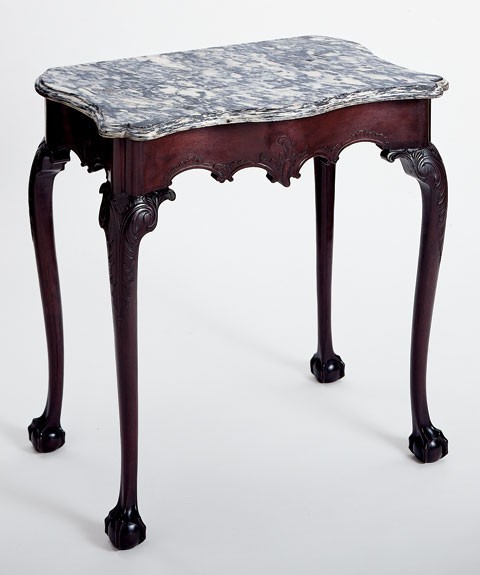
Sideboard table with carving attributed to the shop of James Reynolds, Philadelphia, Pennsylvania, 1766–1776. Mahogany with yellow pine and walnut; clouded limestone. H. 33 1/4", W. 33", D. 21 1/2". (Courtesy, Winterthur Museum.)

Map of the Philadelphia region showing quarries, churchyards, and towns.
Quarries: (a) Henderson, (b) Brooks/Reeseville, (c) Wilkinson/Fritz/Potts, (d) Traquair/Cedar Grove, (e) Marble Hall, (f) Lentz. Churchyards: (1) Saint Peter’s, (2) Great Valley Presbyterian, (3) Great Valley Baptist, (4) Trappe Lutheran, (5) Gloria Dei. Towns: (C) Conshohocken, (M) Malvern, (N) Norristown, (W) Whitemarsh.
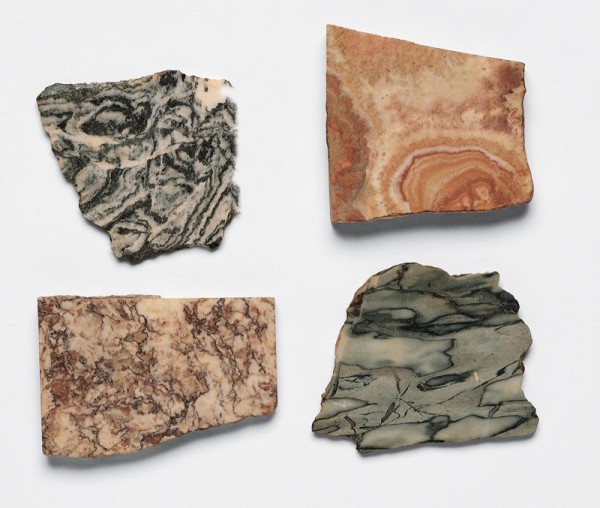
Samples of European marble owned by James Logan (1674–1751). (Courtesy, Fairmont Park Commission.) Logan probably received these samples from colleagues in London. Similar marble appears on furniture used in Philadelphia during the eighteenth century.
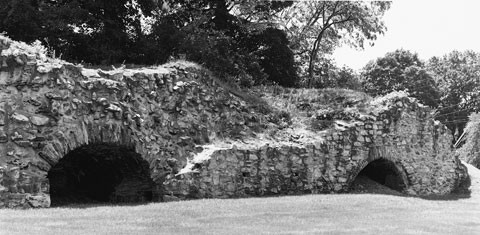
Lime kilns on Germantown Avenue in Plymouth Township, Pennsylvania. (Photo, Gavin Ashworth.) Plymouth Township is approximately twenty miles northwest of Philadelphia. These kilns were loaded from the top with limestone blocks then burned for days.
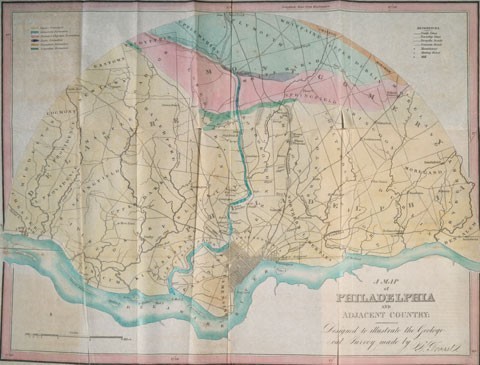
Detail of a geological map of Philadelphia illustrated on page 10 of Dr. Gerhard Troost’s Geological Survey of the Environs of Philadelphia performed by the order of the Philadelphia Society for promoting Agriculture (Philadelphia: H. S. Tanner, 1826). (Courtesy, The Academy of Natural Sciences, Ewell Sale Stewart Library.)
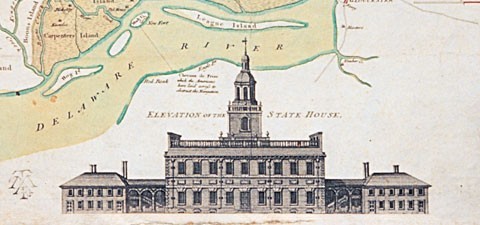
Elevation of the Pennsylvania State House shown on Matther A. Lotter, A PLAN of the City and Environs of PHILADELPHIA, Pennsylvania, 1777. This image shows the north façade which has figured limestone panels between the first and second floor windows and soapstone quoins. (Courtesy, Winterthur Museum.)
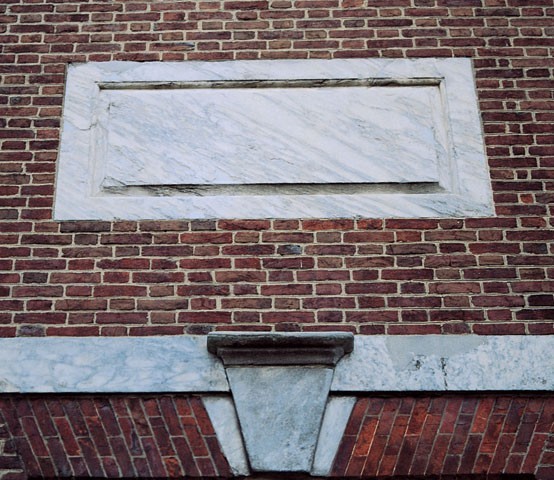
Detail showing a panel and a keystone on the Pennsylvania State House. This fielded panel is one of nine placed between the first and second floor windows of the north façade.
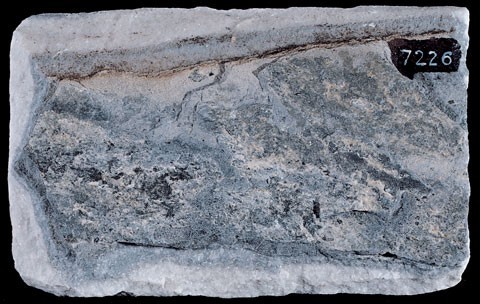
Sample of clouded limestone collected during the first or second geological survey of Pennsylvania at C. Earnest’s quarry between Norristown and Philadelphia. (Courtesy, State Museum of Pennsylvania; photo, Gavin Ashworth.)

Sample of clouded limestone collected during the first or second geological survey of Pennsylvania at a quarry near Upper Merion Township. (Courtesy, State Museum of Pennsylvania; photo, Gavin Ashworth.) The brown diagonal line across the top of the sample is iron, and the large blue areas are deposits of magnesium within the matrix of calcium carbonate.
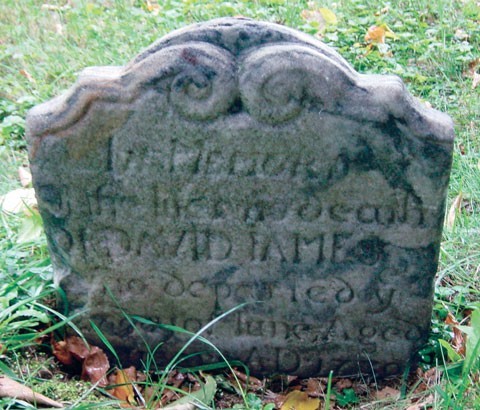
Tombstone for David James, Great Valley Baptist Church, Upper Merion Township, Pennsylvania, dated 1730. (Photo, R. Curt Chinnici.) This is one of the earliest Pennsylvania tombstones made of clouded limestone.
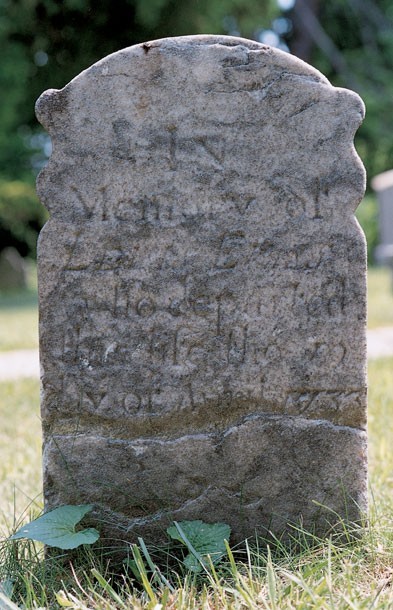
Tombstone with an eroded inscription, Great Valley Baptist Church, Upper Merion Township, Pennsylvania, dated 1733. (Photo, Gavin Ashworth.)
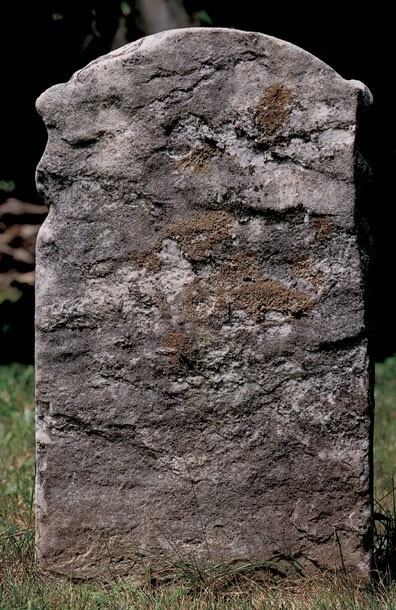
Detail showing the back of the tombstone illustrated in fig. 11.
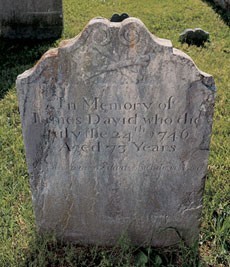
Tombstone for James David, Saint Peter’s Church, Chester County, Pennsylvania, dated July 24, 1746. (Photo, Gavin Ashworth.)

Detail of the back of a tombstone for P. Lloyd, Great Valley Presbyterian Church, Chester County, Pennsylvania, dated April 1802. (Photo, Gavin Ashworth.)
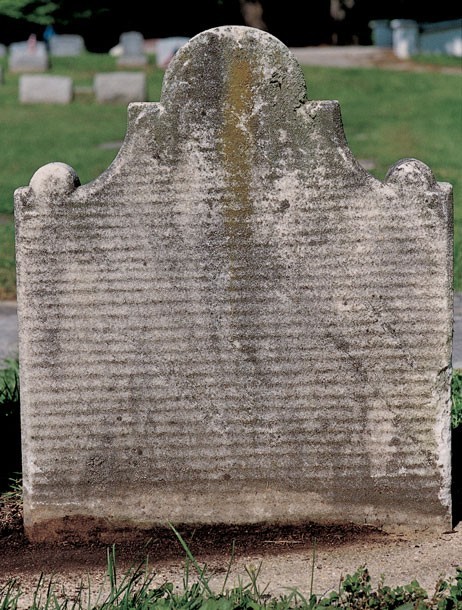
Detail showing the saw kerfs on the back of a tombstone for Major Ezekiel Howell, Great Valley Presbyterian Church, Chester County, Pennsylvania, dated October 4, 1812. (Photo, Gavin Ashworth.)
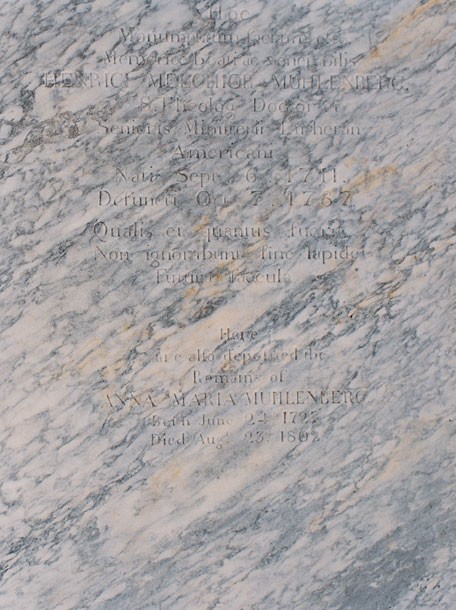
Altar tomb for Henry and Anna Marie Muhlenberg, Augustus Lutheran Church, Trappe, Pennsylvania, dated October 7, 1787, and August 23, 1802. The stone for the tomb was probably cut in 1787. (Photo, Gavin Ashworth.)
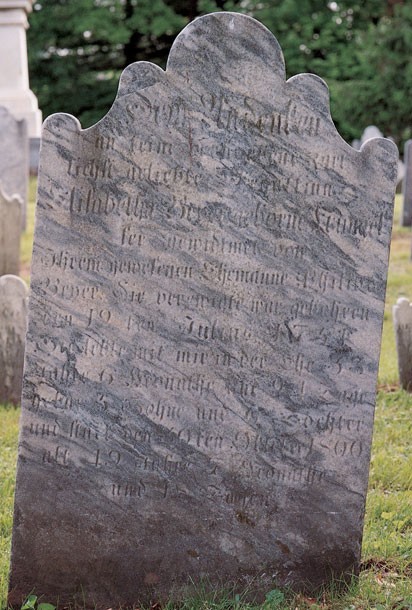
Tombstone with old German script, Augustus Lutheran Church, Trappe, Pennsylvania, dated 1751. (Photo, Gavin Ashworth.)
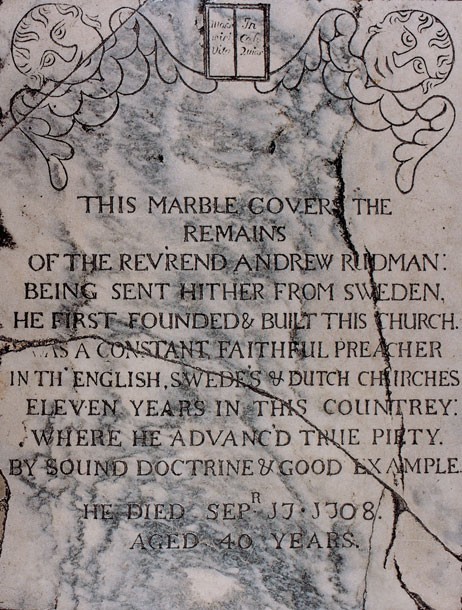
Grave marker for Rev. Andrew Ridman, Old Swedes Episcopal Church, Philadelphia, Pennsylvania, dated 1708. (Photo, Gavin Ashworth.)
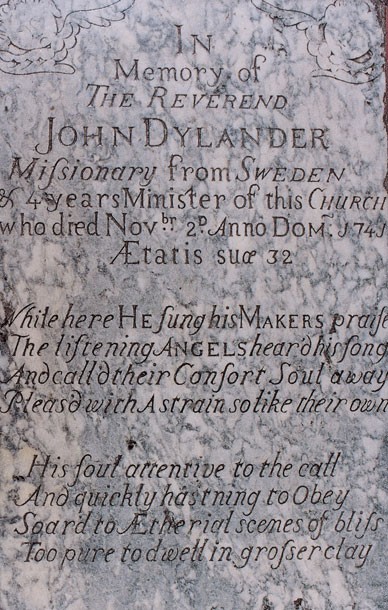
Grave marker for Rev. John Dylander, Old Swedes Episcopal Church, Philadelphia, Pennsylvania, dated 1741. (Photo, Gavin Ashworth.)
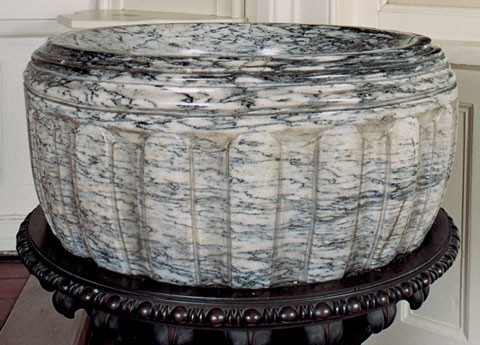
Baptismal bowl, Old Swedes Episcopal Church, Philadelphia, Pennsylvania, eighteenth century. (Photo, Gavin Ashworth.)
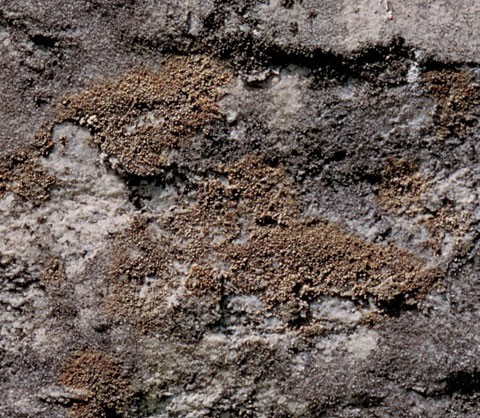
Detail of the back of the tombstone illustrated in figs. 11, 12.

Detail of the underside of the top of the sideboard table illustrated in fig. 30.
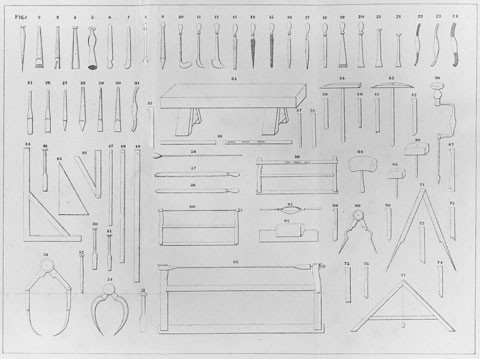
Illustration showing stone cutters’ tools illustrated in The Marble Worker’s Manual. No. 1 — square etching needle; nos. 2, 4, 19, 20, 64 — marteline chisels used for etching and with a mallet or sledge hammer, no. 5 — puncheons; nos. 8, 9, 27, 28 — partly flattened, very sharp etching needles called houguettes; no. 10 — hooks for sinking and leveling cavities; no. 11 — round-nosed chisels for sinking and leveling cavities; no. 12 — sharp edged and notched scrapers for fluting; no. 19 — scrapers for fluting; no. 31 — parting tools bent round and steeled at each end to smooth areas difficult to reach; no. 34 — martelines (iron mallets pointed at one end, and diamond shaped at the other) used to pierce and shell off the marble without splintering; no. 61 — sebillas, or wooden bowls for holding the sand and water that would be thrown under the saw; no. 56 — wooden or metal ladles used with the sebillas; no. 62 — handsaws without teeth, used to cut stone or marble with the aid of sand or water. "A skillful workman often confines himself to making a deep groove in the Marble or stone, and then by a quick blow, separates the two pieces." (Courtesy, Winterthur Museum Library: Printed Book and Periodical Collection.)
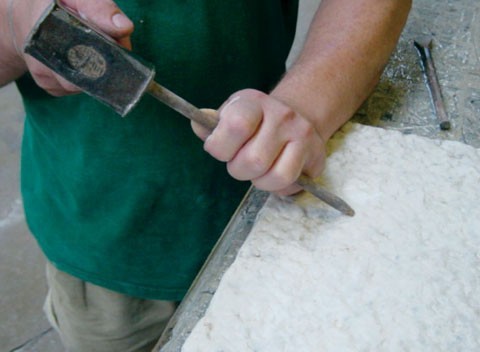
Details showing (from top to bottom): an etching needle and mallet being used to chip away small pieces of stone, a flat marteline chisel being used to level the surface, and a chisel and mallet being used to table the edges of a slab. (Photo, R. Curt Chinnici.) The marteline chisel performs the same function as an etching needle, but it leaves parallel tooth marks.
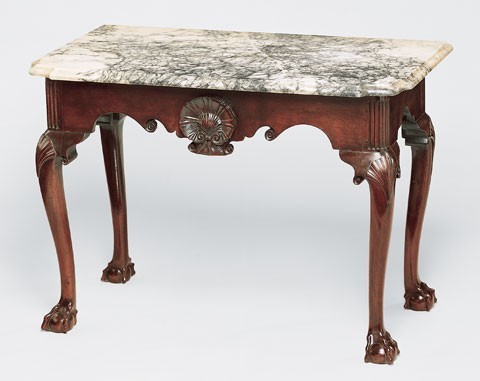
Sideboard table with carving attributed to the shop of Samuel Harding, Philadelphia, Pennsylvania, 1740–1755. Mahogany with yellow pine and white cedar; Italian marble. H. 29", W. 42", D. 22". (Courtesy, Diplomatic Reception Rooms, U. S. Department of State; photo, Will Brown.) The top appears to be the third one used on this frame. Screw pockets on the inner faces of the rails indicate that the table had a wooden top at one point, but its original was probably clouded limestone or marble.
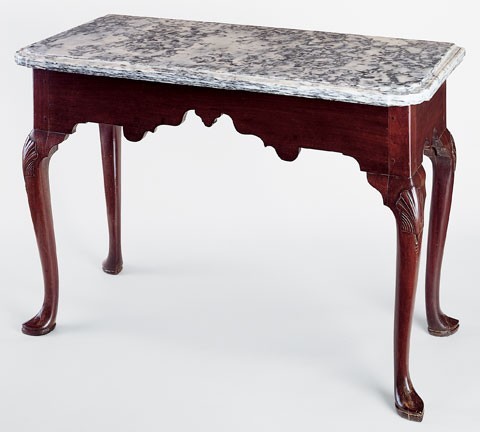
Sideboard table, Philadelphia, Pennsylvania, 1735–1745. Mahogany with tulip poplar; clouded limestone. H. 30", W. 44 3/4", D. 21 1/2". (Courtesy, Baltimore Museum of Art, bequest of J. Gilman D’Arcy Paul; photo, Gavin Ashworth.)
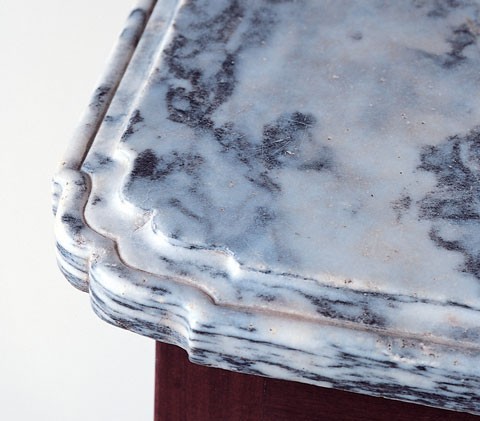
Detail of the edge molding on the top of the sideboard table illustrated in fig. 26.
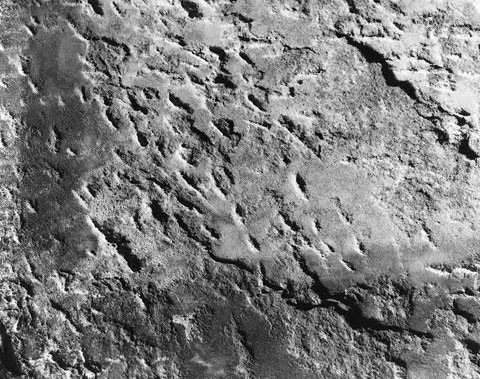
Detail of the underside of the top of the sideboard table illustrated in fig. 26.
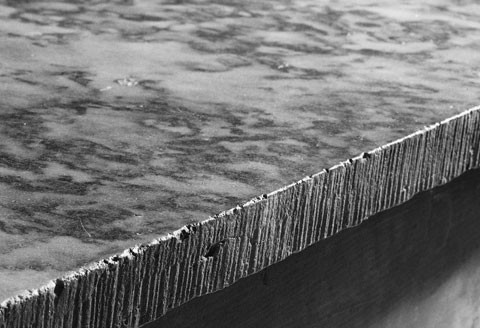
Detail of the saw kerfs on the back edge of the top of the sideboard table illustrated in fig. 26.

Sideboard table attributed to the shop of Henry Cliffton and Thomas Carteret, Philadelphia, Pennsylvania, ca. 1755. Mahogany; clouded limestone. H. 29 1/4", W. 36 1/2", D. 22 1/4". (Private collection; photo, Gavin Ashworth.)

Top of the sideboard table illustrated in fig. 30.
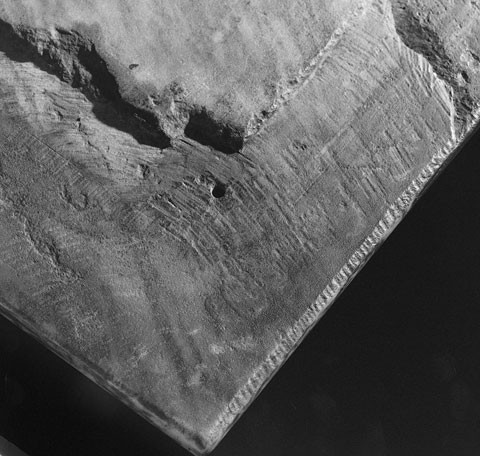
Detail of the underside of the top of the sideboard table illustrated in fig. 30, showing a hole for a metal indexing pin.
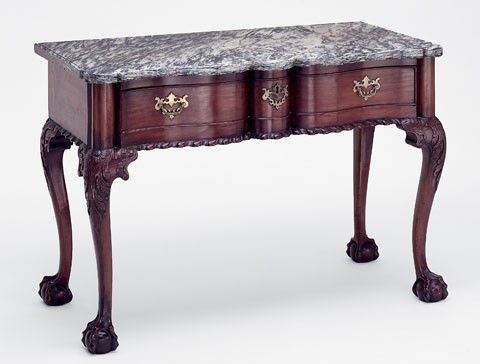
Sideboard table with carving attributed to the shop of Nicholas Bernard and Martin Jugiez, Philadelphia, Pennsylvania, 1760–1770. Mahogany with yellow poplar; clouded limestone. H. 29 7/8", W. 42 5/8", D. 21". (Courtesy, Museum of Fine Arts, Boston; M. and M. Karolik Collection.)
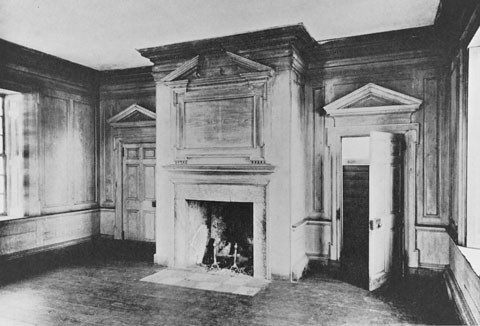
Detail of a chimneypiece and fireplace surround in Graeme Park, Montgomery County, Pennsylvania, 1750–1760. (Courtesy, Winterthur Museum Library: Printed Book and Periodical Collection.) This is the earliest fireplace surround made of highly variegated Pennsylvania limestone in its original location. The horizontal stone is 64" wide and 9 7/8" high. The two supporting side panels are 44" high and 7" wide. The inner edge of the stone has a 3/8" bead on three sides. The bead stops 10" from the floor, which is the same height as the baseboard. On the left panel, a horizontal, scored line indicates the baseboard level. The hearth stones are original, but they have been reset. Similar tiles and limestone surrounds are in later Philadelphia residences including the Physick House.
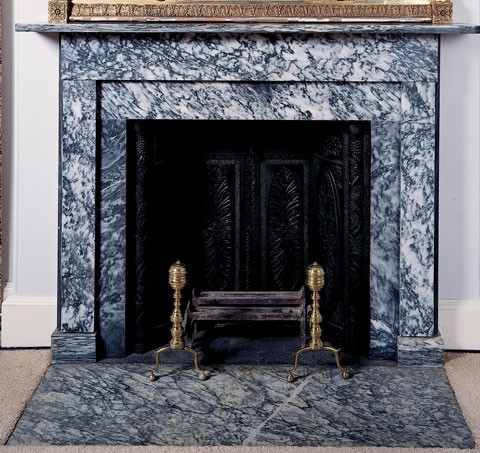
Detail of a chimneypiece and fireplace surround in Andalusia, Bucks County, Pennsylvania, 1833–1835. (Courtesy, Andalusia Foundation; photo, Gavin Ashworth.)
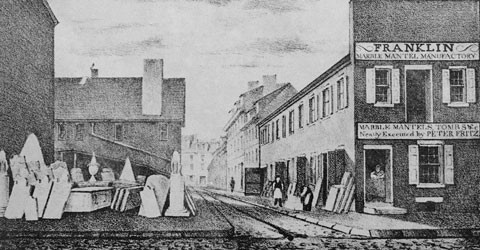
View of Race Street between 6th & 7th, Philadelphia, 1834. (Photo, R. Curt Chinnici.) This image from a newspaper fragment shows the Franklin Marble Mantel Manufactory and funeral statuary owned by Peter Fritz.
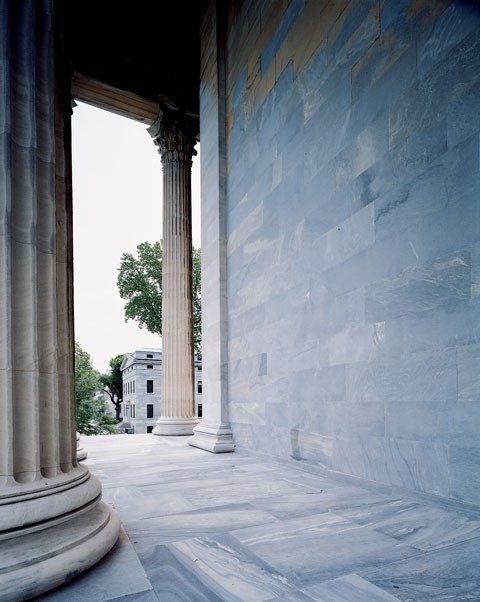
Girard College, designed by Thomas Ustick Walter (1804–1887), Philadelphia, Pennsylvania, 1833–1847.(Courtesy, Girard College; photo, Gavin Ashworth.)
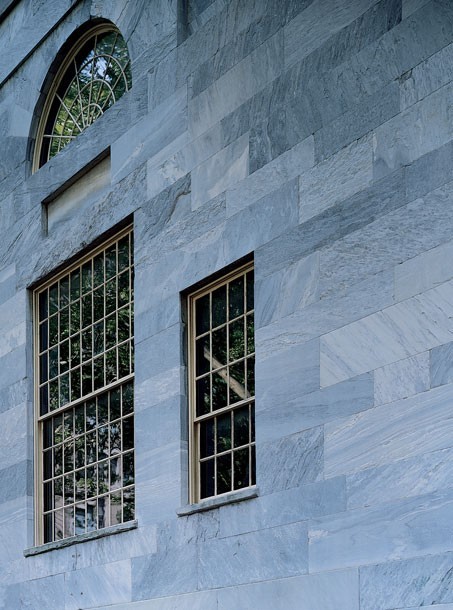
Merchant’s Exchange Building, designed by William Strickland (1788– 1854), South Third and Walnut Streets, Philadelphia, Pennsylvania, 1832–1834. (Photo, Gavin Ashworth.)
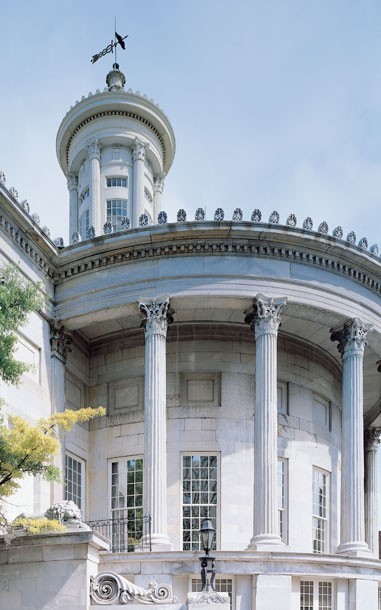
Second Bank of the United States, designed by William Strickland, Chestnut Street, Philadelphia, Pennsylvania, 1818. (Photo, Gavin Ashworth.)
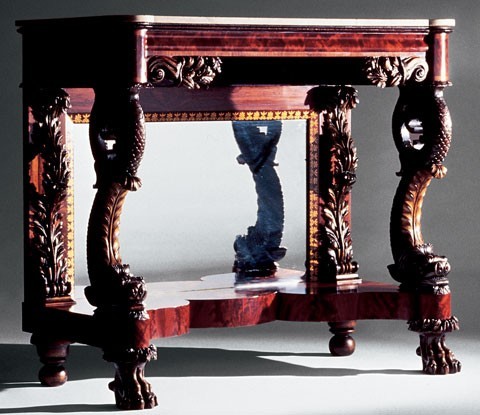
Pier table, Philadelphia, Pennsylvania, 1820–1830. Mahogany and mahogany veneer with pine; imported white Italian marble. H. 43 15/16", W. 50 1/8", D. 23 15/16". (Courtesy, Winterthur Museum.)
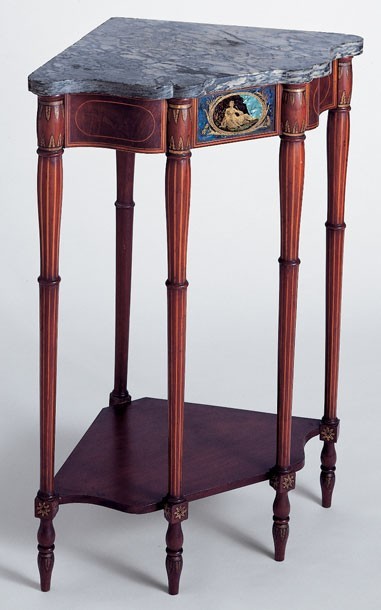
Corner table, Baltimore, Maryland, 1795–1805. Mahogany and satinwood with white pine; clouded limestone. H. 37", W. 27 1/2", D. 20 7/8". (Courtesy, Winterthur Museum.)
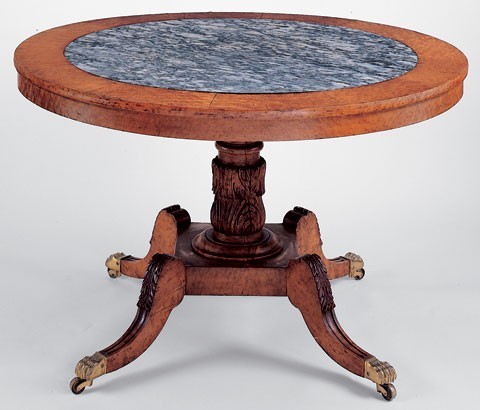
Center table, Philadelphia, Pennsylvania, 1825–1835. Maple and maple veneer with white pine; clouded limestone. H. 27", Diam. of top: 43 5/8". (Courtesy, Andalusia Foundation; photo, Gavin Ashworth.) This table is part of the furniture brought to Andalusia by Nicholas Biddle when he moved from Philadelphia to this country house on a permanent basis.
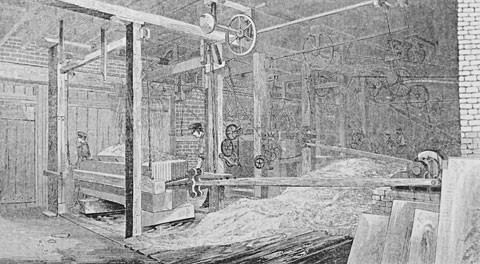
Illustration titled the “Sawing-Rooms of J. & M. Baird’s Steam Marble Works,” from Godey’s Lady’s Book (1853). (Photo, R. Curt Chinnici.)

Washstand, Philadelphia, Pennsylvania, 1830–1845. Mahogany veneer on white pine; clouded limestone. H. 28", W. 28", D. 22 3/4". (Private collection; photo, Gavin Ashworth.) Unlike most nineteenth-century slabs, the top on this stand is rough on the underside and tabled to fit the frame. The tableing actually impedes a towel bar that pulls out on one side. A similar washstand with three drawers has a stenciled label of Anthony Quervelle.
